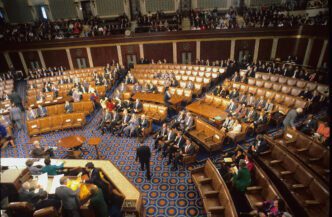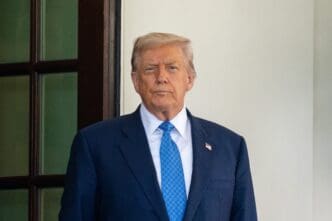Executive Summary
- The U.S. government shutdown is in its third week, stemming from a standoff between Democrats and President Trump primarily over healthcare funding, specifically Affordable Care Act subsidies and Medicaid cuts.
- Democrats’ conventional political tactics are proving ineffective against President Trump’s unconventional approach, which includes threatening more federal job losses and exploring alternative funding to sustain critical services, enabling a longer shutdown.
- Both parties are hardening their resolve, with Democrats unified in their stance and Senate Republicans strengthening theirs, indicating the shutdown is likely to be prolonged and could become one of the longest in U.S. history.
The Story So Far
- The ongoing government shutdown stems from Democrats’ refusal to back a spending bill, aiming to force an extension of expiring Affordable Care Act subsidies and a rollback of Medicaid cuts, which also represents a broader effort to assert their political viability against President Trump’s administration. This high-stakes standoff is prolonged by President Trump’s unconventional political approach, including hardening his stance and exploring alternative funding mechanisms, which challenges traditional pressure tactics and makes a quick resolution difficult.
Why This Matters
- The ongoing government shutdown is poised for a prolonged duration, potentially becoming one of the longest in U.S. history, as President Trump’s unconventional and resilient approach effectively neutralizes traditional Democratic pressure tactics, forcing the opposition to devise new strategies. This stalemate also represents a significant test for the Democratic party, whose political viability and supporters’ confidence hinge on their ability to effectively counter the administration’s policies.
Who Thinks What?
- Democrats initiated the shutdown by refusing to back a spending bill, aiming to extend expiring Affordable Care Act subsidies and roll back Medicaid cuts, viewing this as a necessary stand to counter President Trump’s policies and ensure the party’s viability, with many members and constituents resolved against concession.
- President Trump has adopted an unconventional approach, hardening his stance by reportedly initiating federal worker firings and threatening more job losses in a calculated show of defiance, while also exploring alternative funding mechanisms to potentially enable a longer shutdown and appearing resilient to traditional political pressures.
The United States government remains in a shutdown for a third week as Democrats and President Donald Trump engage in a high-stakes standoff primarily centered on healthcare funding. Democrats initiated the shutdown by refusing to back a seven-week spending bill, aiming to force Republicans to extend expiring Affordable Care Act subsidies and roll back Medicaid cuts. However, an analysis suggests that while Democrats employ conventional political tactics, they may be underestimating President Trump’s unconventional approach to the impasse.
Shutdown Dynamics and Democratic Strategy
Democrats initially perceived their strategy as effective, successfully highlighting looming health insurance premium hikes and opening divisions within the Republican Party. The opposition party has demonstrated a willingness to stand firm, defying expectations of an immediate compromise.
However, the current political climate, influenced by President Trump, challenges traditional assumptions about government shutdowns. The analysis notes that President Trump often deviates from conventional political playbooks, making it difficult for standard pressure tactics to be effective.
President Trump’s Unconventional Approach
President Trump has reportedly hardened his stance, initiating the firing of thousands of federal workers and threatening more job losses in what is described as a calculated show of defiance. He has also explored alternative funding mechanisms, such as diverting tariff revenues to ensure critical services like military pay and nutrition assistance for vulnerable populations continue, potentially enabling a longer shutdown.
The political environment is further complicated by President Trump’s engagement with multiple international and domestic issues, which can overshadow the healthcare debate in Washington. His apparent resilience to the mounting human and economic costs of the shutdown is also highlighted as a factor in the ongoing stalemate.
Congressional Reactions and Public Opinion
To break the impasse, Democrats may need to devise new methods of political pressure that President Trump cannot easily neutralize, or identify incentives that might prompt him to negotiate. The challenge lies in confronting a president described as disregarding traditional political norms and legal constraints.
Senator Bernie Sanders, an independent who caucuses with Democrats, expressed skepticism about immediate negotiations, stating, “Anyone that thinks that tomorrow they’ll suddenly start negotiating, I think is smoking something that is illegal in many states.” Democratic Representative Alexandria Ocasio-Cortez affirmed her party’s resolve, urging them not to “fall for the fine print, not falling for the tricks and not falling for the politics around this.”
Despite Democratic efforts, the resolve among Senate Republicans appears to be strengthening. Senator John Kennedy of Louisiana predicted a prolonged shutdown, suggesting it could be “the longest shutdown in the history of ever.”
Early polling indicated that most voters initially blamed President Trump and Republicans for the shutdown. However, more recent surveys suggest that the political fallout has not yet been disastrous for either party. A CBS News poll showed 52% disapproval for President Trump’s handling, with congressional Republicans at 52% and Democrats at 49%.
Broader Democratic Motivations
Beyond the immediate issue of healthcare, the shutdown represents a broader struggle for Democrats, who have faced challenges in countering President Trump’s policies and actions. The party’s viability and the confidence of its supporters are seen as contingent on their ability to stand firm in this confrontation.
Senator Tim Kaine of Virginia, a state significantly impacted by federal furloughs, reported that his constituents are not advocating for concession. He conveyed their sentiment: “We’re tired of the layoffs, we’re tired of canceling economic development projects… It’s time to draw the line and stop it.”
The core Democratic argument, rooted in rising healthcare costs, remains a potent concern for millions of Americans. Even some Republicans, such as Representative Marjorie Taylor Greene, reportedly agree with the position on Affordable Care Act subsidies. Senator Jeff Merkley of Oregon noted strong constituent support for continuing the fight over healthcare.
Outlook for the Stalemate
With both sides currently lacking sufficient political incentive to yield, the shutdown could continue for an extended period. Potential future leverage points, such as the Thanksgiving holiday and its anticipated travel disruptions due to understaffed airports, are still several weeks away, suggesting a protracted battle.
Key Takeaways
The ongoing government shutdown highlights a fundamental clash between traditional political strategies and President Trump’s unconventional approach. While Democrats are unified in their fight for healthcare subsidies and broader political resistance, President Trump’s tactics and apparent resilience to conventional pressures suggest the stalemate may persist, potentially making this one of the longest shutdowns in U.S. history.








